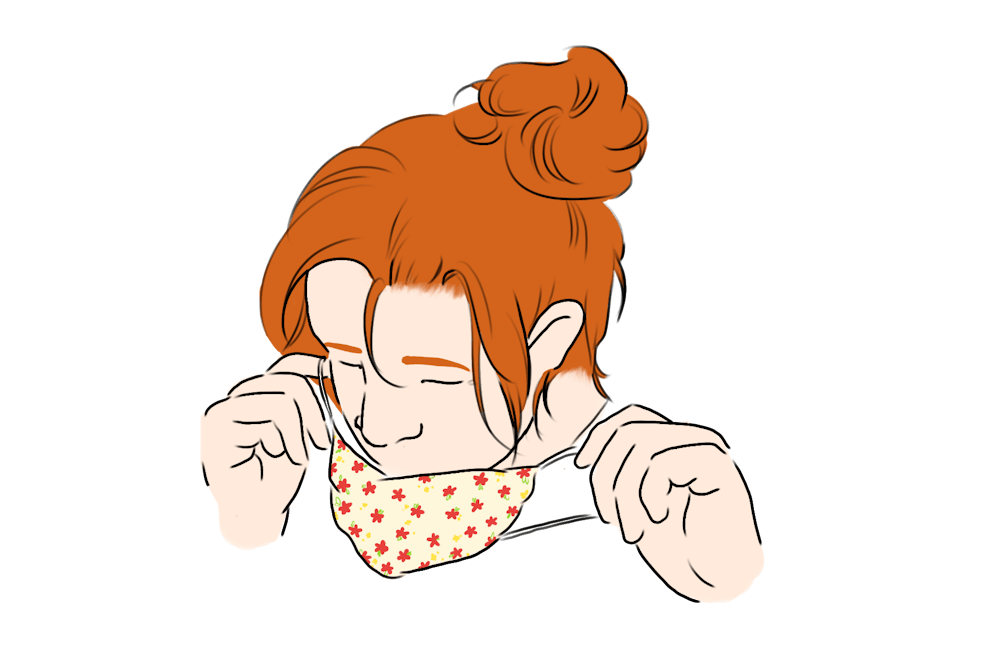After prodding his nostrils with an all-too-familiar nasal swab, Arnav Singhal ’26 started a 15-minute timer on his phone. Earlier that day, Singhal’s suitemate had tested positive for COVID-19.
As Singhal waited, he thought about the headaches and sickness he’d started to experience the night before — symptoms that led him to skip his classes earlier that day. His eyes wandered back to the small white test card in front of him.
Two lines stared back at Singhal. Like his suitemate — and many others on campus — Singhal tested positive for COVID-19, four years after the start of the pandemic.
A September “mini-spike” in COVID-19 infections among college students is not out of the ordinary, according to Ashish Jha, dean of the School of Public Health and the Biden Administration’s former White House COVID-19 response coordinator.
The beginning of the school year often entails higher infection rates, as students return to campus after spending their summers around the globe, Jha explained.
In August, national health officials at the Centers for Disease Control and Prevention described COVID-19 as endemic, meaning that the virus will continue to circulate regularly — similar to the flu. While not all public health professionals agree, the Rhode Island Department of Health also considers COVID-19 endemic in the state.
Brown currently manages COVID-19 as it would the flu and other infectious diseases, but many students find that the illness remains far more difficult to navigate.
Exposed students feel they have insufficient guidance
Less than 48 hours before Singhal tested positive, Chloe Daniel ’27 spent her evening frantically texting friends for a spot on their dorm room floors. The night of Sept. 25, Daniel’s roommate tested positive for COVID-19, just days after Daniel herself suffered a concussion.
After several hours of messaging, Daniel found a temporary safe haven for that first night. The next morning, she made her way to the Office of Residential Life, expecting they would be able to provide her with a more reliable solution.
To her dismay, it took over a half-dozen confusing phone calls before ResLife set her up with five days in a single dorm room in an on-campus residence hall.
According to Daniel, during one of these phone conversations, an Administrator on Call told her that the University no longer had a policy for temporary COVID-19 housing, explaining that the virus was “not a big deal anymore.”
The Administrator on Call told Daniel that she and her friends should have established a room-rotation system to be “more prepared for a situation like this,” Daniel recalled. “I was like, ‘Well, I can’t stay with a friend, because all the friends that I could stay with have been worried that I would expose them to COVID,’” she added.
Daniel said she felt it was unreasonable for the University to rely on other students to house her. She also said the University only seemed to provide a solution because of her constant pestering.
“You require me to live on campus because I’m a sophomore, but you’re not going to provide me anywhere to stay when a crisis occurs?” she said.
Brown offered designated housing for isolation up until the 2022-23 academic year, when it began to encourage students to remain in their housing upon a positive COVID diagnosis, University Spokesperson Brian Clark wrote in an email to The Herald. Since then, the University has advised infected students with roommates to adhere to masking and sanitization protocols, while roommates who test negative may stay in their room or with nearby friends or family.
“Support for students with COVID-19 has continued to be available,” Clark wrote. “Our planning and decisions were based on expert medical and public health guidance at all points and the reality that COVID-19 will continue to be present at times, much in the way that influenza and other respiratory viruses are each year.”
Though Daniel acknowledged that vaccinations have decreased COVID-19 risks, she stressed the need to approach the virus more seriously to protect students.
“I’m already behind from my concussion,” Daniel said. “If I have COVID, I’m going to be another week behind. And frankly, at this school, that will screw me over.”
Confusion over health protocols
Coursework was also on Singhal’s mind when he tested positive later that week. Fortunately for him, Singhal’s professors were accommodating and allowed him to miss class and submit assignments late.
To Singhal, COVID-19 felt like any other sickness — except maybe his friends were less “lax” in coming into contact with him. But his experience was still marked by confusion. When it came time to go back to class, he was unsure how long he was supposed to wait before leaving isolation and the status of public health recommendations.
Students used to be able to turn to the Healthy Brown website to access information regarding the University’s response to COVID-19 and the most relevant health protocols.
The University archived the website in August 2024, a decision that “followed two full academic years of managing COVID-19 on campus in a similar way to other infectious diseases,” Clark wrote. Students can find information and support via Brown Health Services, he added, and the archived website lists guidelines for current health protocols.
The University previously tracked COVID-19 cases and provided community members with a weekly “COVID-19 Campus Safety Update” that outlined the number of reported positive cases. The last available update logged on the archived website was from May 2022.
RIDOH also used to report data on COVID-19 case counts and test results, but stopped in August of this year, RIDOH Spokesperson Annemarie Beardsworth wrote in an email to The Herald. Later this month, the agency will update COVID-19 wastewater data — an indicator of COVID-19 presence in a population obtained by measuring virus levels in sewage — before switching to a new CDC wastewater metric, Beardsworth added.
Factoring in the data
For Caroline Cunfer GS, a member of the Rhode Island Mask Bloc and an advocate for more protective COVID-19 policies, wastewater data indicates the scary reality of continued infection and disease risk.
She points to the end-of-summer virus surges this year, which seem to be higher than the figures this time last year.
This year saw one of the highest COVID-19 summer surges, Jha said, but now infection numbers are beginning to decline — a trend that will continue through the next couple of months.
Jha explained that COVID infections typically follow two waves — one over the holidays and another starting in the summer.
Cunfer said she constantly feels unsafe on campus, especially following the University’s lifting of mask mandates and loosening of virus protocols. For her, there is a “cognitive dissonance” among University leaders and community members who do not understand that “we’re still living through an unmitigated pandemic,” she said.
“I feel like I am living in an alternate reality,” Cunfer explained. “It’s really alienating. I feel unsafe in my workplace. I feel unsafe in most social situations. I say no to a lot of things because I don’t feel safe.”
For Jha, much of the rhetoric in favor of a return to stringent COVID-19 policies results from fear-mongering. “What is the benefit of avoiding COVID at all costs? Get vaccinated. If you’re in a very high risk group, get treated,” Jha said.
Cunfer highlighted the prevalence of long COVID — a chronic illness that some develop after a COVID-19 infection that can involve persistent virus-like symptoms. Long COVID largely occurs in unvaccinated patients, Jha said, and the chances of developing the condition are very low for a vaccinated individual.
“That’s not to minimize the risk of the suffering of people who already have long COVID,” Jha added. “We’ve got to figure out how to take better care of them.”
Jha also explained that the vast majority of those getting very sick are elderly patients, whereas young or middle-aged demographics typically bounce back. He highlighted that the main COVID-19 strategy is to ensure that high-risk people — older people and people who are profoundly immunocompromised — get updated on their vaccines.
For Amanda Votta GS, who suffers from a chronic illness and is immunocompromised, COVID-19 risk has “impacted so many aspects of life.”
“Everything becomes kind of scary,” Votta said. “You become kind of afraid to do things, because if you get sick, what’s going to happen to you? How bad is it going to be?”
Votta contracted COVID-19 in February and was diagnosed with long COVID shortly after. “You just feel this level of exhaustion constantly that nothing alleviates,” Votta explained. “It doesn’t matter if you get a good night’s sleep. It doesn’t matter if you rest during the day. It never goes away.”
For Votta, the loosening of pandemic-era public health policies renders disabled and vulnerable communities invisible. The fact that COVID-19 might not be “killing people outright doesn’t mean that it’s not disabling (people) still, and further disabling people who are already living with pre-existing disability,” she said.
Jha emphasized that while being extra careful around profoundly immunocompromised individuals is appropriate, today’s COVID — with effective vaccines and treatments — generally poses a lower risk to individuals than at the height of the pandemic, whether or not they are immunocompromised.
“We have to live in a reality-based world where facts and data have to matter,” Jha said.

Tom Li is the editor-in-chief and president of The Herald's 135th editorial board. He is from Pleasanton, California and studies economics and international and public affairs. He previously served as a metro editor, covering the Health & Environment and Development & Infrastructure beats, and has worked on The Herald's copy editing, editorial page board, design and podcast teams.





